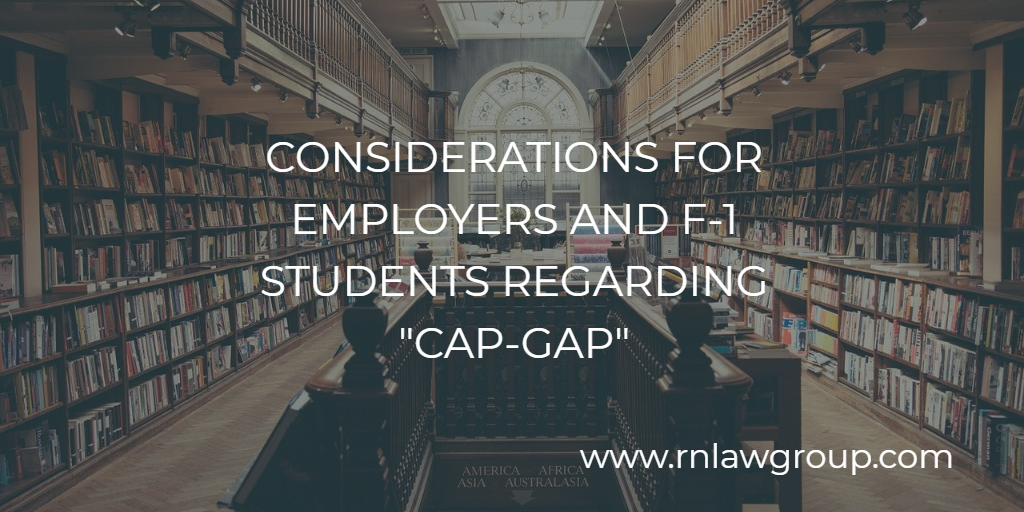
Considerations for Employers and F-1 Students Regarding the Cap-Gap Extension
Two years ago, USCIS changed the way it runs the H-1B lottery process. Since these changes do not require an immediate filing of an H-1B petition, it is important for F-1 nonimmigrants that are on OPT/STEM OPT that are looking to utilize cap-gap to understand what needs to be done to qualify for cap-gap and it is important for employers to make sure they submit timely filed H-1B cap petitions in order to qualify the F-1 student for cap-gap.
This year’s H-1B electronic registration for the H-1B lottery was completed on March 25th, and USCIS began notifying employers of their selections on March 27th. Companies who had their cases selected were given a 90 day window starting April 1 to file the complete H-1B petition. It is important to note, as will be discussed more below, that the registration or even the selection alone does not qualify a person for cap-gap. Their employer will be required to file a complete H-1B petition with USCIS in order to be eligible for cap-gap.
What is cap-gap and how does one qualify?
8 C.F.R. § 214.2(f)(5)(vi) is the regulation which addresses cap-gap. In this regulation, F-1 students can qualify to have their duration of status and OPT extended to expire on September 30th of the same year in which the H-1B is filed. In order to qualify for cap-gap, the following requirements must be met:
- The H-1B petition was filed as a change of status.
- The H-1B was timely filed.
- The H-1B requests an employment start date of October 1 of the same year. This means that if you file your H-1B in the lottery in the spring of 2021, you must request an employment date of October 1, 2021.
- While not listed in the regulation, the OPT must not be expired by the time the H-1B is filed.
When SEVIS receives data about a pending H-1B petition from USCIS, SEVIS should update the record to show the cap-gap extension. However, if SEVIS failed to update the system, the designated school official (DSO) can request a data fix with the SEVP Response Center to add the cap-gap extension to the student’s record. With the cap-gap notation, the student can continue to work until September 30th unless the H-1B gets denied or withdrawn. A denial or withdrawal of an H-1B ends cap-gap eligibility.
How does the H-1B electronic registration system impact cap-gap?
In previous years, the H-1B lottery would be completed in the first week of April with employers filing complete H-1B petitions at this time. Receipt notices for selected cases would start coming in within a couple of weeks of filing, and thus, cap-gap could be applied for fairly quickly. However, with the implementation of the H-1B electronic registration system in 2020, companies will not be able to file a complete H-1B petition until they are notified the registered individual was selected.
USCIS made it clear in the H-1B registration regulation comments and DHS responses, that the selection of a case through the registration system DOES NOT qualify an individual for cap-gap. In compliance with C.F.R. § 214.2(f)(5)(vi) addressed above, USCIS will still require the entire petition to be filed as a change of status and meet all other requirements before the F-1 student is eligible for cap-gap.
What should employers do once they receive selection notices?
When companies receive notification of their selected registrations, they will be given at least 90 days to file the H-1B petition. Employers need to prioritize their filings in order to ensure that F-1 students can take advantage of cap-gap before their OPT expires. Further, employers should consider being prepared with all documents necessary to file the complete H-1B petition so that they can file as soon as possible for employees with OPT that is about to expire. Reddy & Neumann recommends filing the LCA as early as possible in order to prepare for those selected cases that may need a quick turnaround because of OPT expiration. It can take around 7 days for the LCA to get certified and can significantly delay filing. For example, if an F-1 student has OPT valid until May 1st, and the company was just notified of their selection on March 27th, if the company already has a certified LCA, they can finalize the H-1B, mail it, and have it delivered to USCIS way in advance of the May 1st date so that the F-1 student can be eligible for the cap-gap extension.
Again, it is important to note that the registration or the selection in registration DOES NOT qualify an F-1 student for cap-gap. It is important for employers and their employees currently on F-1 status to work together to ensure timely filing of their H-1B cap petition and to remain mindful of the OPT expiration date. If you have questions about whether a situation qualifies for cap-cap, contact a Reddy & Neumann attorney.
By: Steven A. Brown

